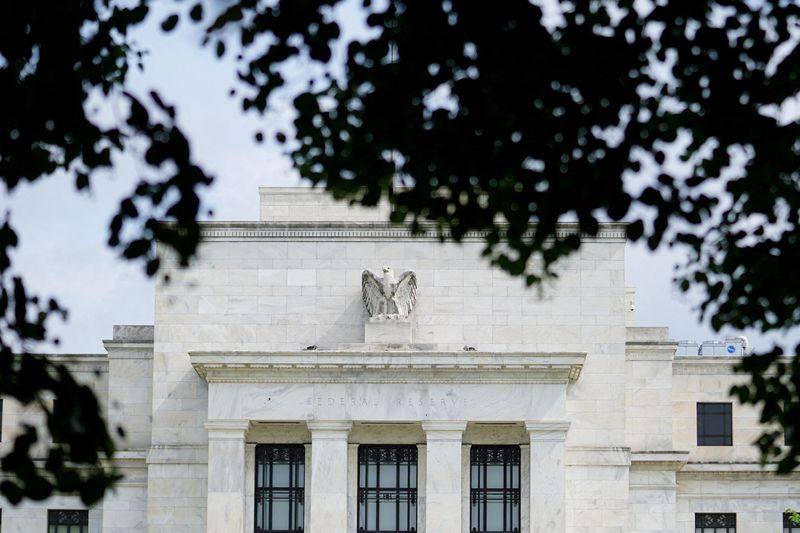Surging US repo activity likely exacerbating funding pressure
2024.10.11 05:29
By Gertrude Chavez-Dreyfuss
NEW YORK (Reuters) – A sharp steady rise in overnight repurchase agreements is overwhelming banks that serve as middlemen for such short-term borrowings in U.S. government securities, threatening to fuel major funding pressure at the end of every quarter and year.
The market for so-called repos allows banks to borrow money quickly and cheaply when they need cash, and lend with little risk. Hedge funds and Wall Street financial firms rely on the roughly $4 trillion repo market to finance daily trades, and any disruption could force them to cut holdings of bonds, stocks and other securities.
Borrowers use Treasuries or other debt securities as collateral, agreeing to repurchase them in the future at a pre-determined price. A typical repo transaction involves a dealer borrowing cash from a money market fund and lending the cash to a client such as a hedge fund.
Repo demand has always been high because these transactions are more efficient in mobilizing cheaper and deeper funding for financial intermediaries and borrowers as they reduce dependence on commercial banks. Its volume has surged even higher as trading strategies that depend on them have become more popular, while primary dealers are reluctant to boost capital reserves required to handle more trades.
Repo rates jump when banks pull away from acting as middlemen at quarter- and year-ends due to higher balance sheet costs required at those times for reporting purposes.
That happened at the end of the third quarter on Sept. 30. The secured overnight financing rate (SOFR), the cost of borrowing short-term cash, soared 13 basis points (bps) over the effective federal funds rate of 4.83%. It was 22 bps higher on Oct. 1.
That squeeze harkened back to September 2019 when funding costs soared due to a large drop in bank reserves as corporations tried to meet a tax deadline and make payments for Treasury debt settlements.
“It is absolutely the kind of hiccup that needs attention,” said Lou Crandall, chief economist at Wrightson ICAP (LON:), to a point where the Federal Reserve could address it at one of its meetings.
Funding conditions have stabilized, with SOFR at 4.83% and the broad general collateral rate, another repo rate, at 4.82%. But analysts believe this could end up being a systemic issue that creates more volatility in the overnight market, keeping short-term rates elevated.
“There is an inelastic demand for repo that exists on a daily basis and that doesn’t change whether it’s quarter-end, or it’s year end,” said Jan Nevruzi, U.S. rates strategist at TD Securities. “But when dealers pull away from intermediation like it does during those periods, it creates issues like that.”
What happened at the end of September was mostly about dealers’ inability to meet demand for repo financing, Wrightson’s Crandall said.
“There was not enough intermediation capacity to … finance all repo positions. We have been seeing signs … of the explosive growth of certain segments of the repo market that has been creating congestion on dealer balance sheets and the market in general,” Crandall said.
SOARING VOLUME, BASIS TRADES
Fed data showed SOFR volume soared to a record $2.5 trillion on Sept. 30. from $2.07 trillion the day before. Treasury repos cleared through another platform called the Delivery-versus-Payment (DVP) service also jumped to $1.7 trillion on Sept. 30 and have been in the trillions of dollars the last couple of months.
Analysts said one reason for the jump in repo volume was the surge in so-called basis trades, a trading strategy which takes advantage of the difference in price between cash Treasuries and futures. These are financed in the repo market and their size has exploded with record bets against Treasury futures amassed by leveraged funds.
Since the Fed launched its hiking cycle in 2022, hedge funds have been buyers of Treasuries, hedging that position by selling futures to asset managers who use these instruments to meet benchmark needs in their portfolios.
“There are clear signs of money market sensitivity to shifts in the amount of cash in the system and the amount of collateral in the system, and to dealer balance sheet constraints,” said Mark Cabana, head of U.S. rates strategy, at BofA Securities.
One sign of primary dealers’ balance sheet stress is their record holdings of Treasuries seen a few weeks ago following a global sell-off in risk assets that pushed investors to buy safer U.S. government debt. Their Treasuries positions have eased, but remained elevated.
Dealers would rather hold less Treasury debt. As middlemen, primary dealers buy and sell bonds, making money on the difference, or so-called bid-ask spread. The bigger the trading volume, the higher the profits.

While repo financing accounts for a large share of dealers’ overall balance sheet, analysts said it is not as profitable for them to do it these days, with the SOFR below the interest on reserve balances (IORB) currently at 4.90%, or the rate paid on bank reserves held at the Fed. Dealers would much rather have their funds sit as reserves at a higher rate than lend to hedge funds.
Overall, primary dealers have no desire to expand their balance sheet because it entails higher leverage charges that would require more capital, TD’s Nevruzi said.








